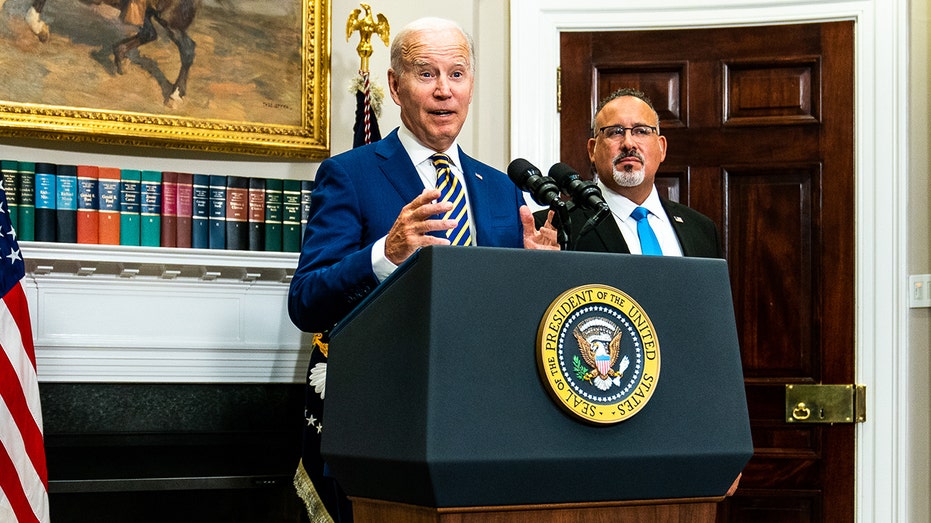Debt ceiling bomb nears as government spending balloons
Treasury will soon deploy 'extraordinary measures' to stay below the ceiling
CBO estimates Biden's student loan handout will add $400B to national debt
Congressional correspondent Chad Pergram details how much the president's student loan handout will actually cost the federal government on 'Cavuto: Coast to Coast.'
The federal government is within spitting distance of the congressionally mandated limit on how much money it can borrow.
And it will soon be forced to undertake a series of money managing techniques to avoid exceeding the debt ceiling until Congress raises it.
Under federal law passed in late 2021, the most the federal government can borrow is $31.381 trillion. Total national debt has already ventured slightly above that level, but a small portion of the debt is exempt from the debt ceiling – technically, the unamortized discount on Treasury bills. As of last week, total debt subject to the debt limit got as close as $31.345 trillion.
That leaves the government very close to its borrowing limit at a time when congressional Democrats are considering a wave of new spending before they give up control of the House to Republicans in January.
DEMOCRATS COULD ADD $500B IN NEW DEBT DURING FINAL WEEKS OF CONGRESSIONAL CONTROL

Treasury Secretary Janet Yellen will have to manage federal spending to ensure the national debt ceiling is not breached. (AP Photo/Jose Luis Magana, File / AP Newsroom)
In the past, the government has been able to last for months once it hit the debt ceiling as it waited for Congress to either raise the ceiling or suspend it entirely, a move that would allow the government to borrow whatever it needs. But hitting the debt ceiling does send a warning that Congress will need to act in the near future. And approving an extension this time around could prove to be more politically difficult now that Republicans will control the House in the next Congress.
THE NEXT US DEBT CRISIS: MAKING HUNDREDS OF BILLIONS IN INTEREST PAYMENTS
Democrats would prefer to raise the debt ceiling in the lame-duck session of Congress, since they worry Republicans will have more leverage to press for spending cuts as part of a debt ceiling deal once the GOP takes over the House in January.
But last week, outgoing House Speaker Nancy Pelosi, D-Calif., indicated a debt ceiling increase might have to wait.
"I hope that we could do the debt ceiling this year, but we are striving to do it in a bipartisan way," she said.
House Minority Leader Kevin McCarthy, R-Calif., has indicated Republicans will push for a commitment to slow the growth of federal spending or find spending cuts as a condition of approving a debt ceiling increase. Republicans and many economists have said excessive federal spending has ramped up demand in the economy and caused inflation, which the Federal Reserve has been trying to tamp down by raising interest rates.
"We can’t continue down this path," McCarthy said in October when asked about high levels of federal spending.
BIDEN'S DEFICIT REDUCTION BRAG MASKS COLOSSAL WAVE OF NEW SPENDING
Even though the U.S. is approaching its debt ceiling, President Biden continues to boast about how the annual budget deficit has fallen under his watch, from $2.8 trillion in fiscal 2021 to about $1.4 trillion in fiscal 2022. That smaller deficit mostly reflects rising federal revenues and far less emergency spending on the COVID pandemic compared to 2020 and 2021.

President Biden announced a student loan handout that boosted the budget deficit by $400 billion. (Demetrius Freeman/The Washington Post via Getty Images / Getty Images)
Overall spending levels remain high, and budget watchers say it will be hard to reduce the budget deficit much further in light of Biden's expanded spending priorities. The government spent $4.4 trillion in 2019, the year before the pandemic, but spent $6.5 trillion in 2020, $6.8 trillion in 2021, and $6.3 trillion in 2022. And it is likely to keep spending more than $6 trillion per year barring significant spending cuts.
Treasury Secretary Janet Yellen will likely inform Congress in the coming days that the debt ceiling has been reached and indicate how long the government can continue to run without breaching the ceiling. Staying under that limit will be done through what Treasury calls "extraordinary measures."
BIDEN'S STUDENT LOAN HANDOUT COST $426 BILLION, BOOSTED 2022 BUDGET DEFICIT TO $1.4 TRILLION: CBO
In the past, those measures have included halting the issuance of state and local government securities and temporarily halting investments in federal employees’ retirement and disability plans. Treasury can also suspend other routine investments and the issuance of other securities and cash in securities it owns earlier than anticipated to raise money.
Treasury's target is to keep the total national debt at least $25 million under the debt ceiling.

Signage is seen at the United States Department of the Treasury headquarters in Washington, D.C., Aug. 29, 2020. (REUTERS/Andrew Kelly / Reuters Photos)
Treasury’s stated position is that raising the debt ceiling does not authorize new spending commitments and instead allows the government to finance current obligations already approved by Congress. But a higher debt ceiling does give the government room to take on new commitments that were not anticipated by Congress.
For example, Biden approved a student loan handout in the summer that cost the government more than $400 billion, months after the debt ceiling was increased.
CLICK HERE TO GET THE FOX BUSINESS APP
When Congress does address the issue, it will have the option of either setting a new debt ceiling or suspending it, or – theoretically – drastically cutting back spending to stay under the current ceiling. When asked in mid-October if he would support eliminating the debt ceiling altogether, President Biden said, "No, that'd be irresponsible."
In early October, the national debt hit $31 trillion for the first time ever.
